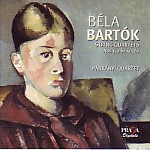In Bartók’s first two quartets, the Párkányi Quartet does its finest work in slow moving, introspective passages. For example, although the composer writes “molto espressivo” over the First Quartet’s long-winding introduction, the musicians’ near-threadbare sonority and minimal use of vibrato underlines the music’s emotional proximity to late Beethoven. Paradoxically, they bring more tonal heft and lyrical warmth to the muted portions of the Second Quartet’s lento finale, allowing the lush harmonies to sexily resonate. But when it comes to clarifying Bartók’s frequent changes in tempo and pulse, the Párkányis prove less adroit than the brisker, more effortlessly integrated Takacs performances on Decca in the Second’s central movement and the First’s Finale. Praga’s engineering is robust enough to nearly transform the Párkányis into an orchestra, if not so agile a quartet as any one of our three references.
































